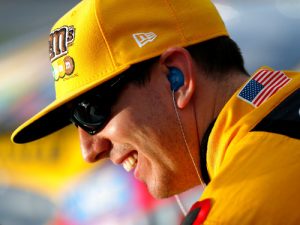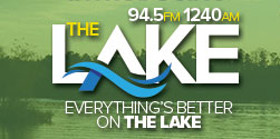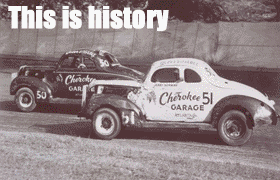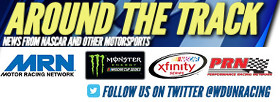
Kyle Busch looks on from the garage during practice for Sunday’s Monster Energy NASCAR Cup Series race at Las Vegas Motor Speedway. Photo by Sean Gardner/Getty Images
Early in the 2017 Monster Energy NASCAR Cup Series season, Fords have dominated the headlines.
Kurt Busch won the season Daytona 500 in a Stewart-Haas Racing Ford. Brad Keselowski won the following week at Atlanta. Kevin Harvick has won three of the four preliminary stages contested under NASCAR’s enhanced three-stage race format.
Harvick led 292 laps at Atlanta and dominated the race before a late pit road speeding penalty opened the door for Keselowski. Coming to Sunday’s Kobalt 400 at Las Vegas Motor Speedway, Harvick, Busch and Keselowski were 1-2-3 in the series standings.
Keselowski backed that up with a pole-winning run at LVMS on Friday.
The performance of the Fords early this season is a radical departure from 2016, when the Toyotas of Joe Gibbs Racing and Furniture Row were the dominant cars through the first half of the regular season.
Thus far in 2017, Kyle Busch won Stage 1 in the Daytona 500, Denny Hamlin won the second Can-Am Duel at Daytona, Matt Kenseth rallied from a lap down to finish third at Atlanta, and Martin Truex, Jr. qualified on the outside of the front row on Friday at Las Vegas.
Otherwise, the highlight reel has been underwhelming for the Camrys, but Kyle Busch says there are mitigating circumstances for the spotty performance.
“I think there was a good run going for Erik Jones, actually, last week (14th at Atlanta),” Busch said. “He probably should have finished sixth to eighth, ninth maybe, somewhere in there. And you know, the 78 car (Truex) was running okay, as well, too. I don’t know where the rest of our cars were running. Obviously, Matt (Kenseth) had a decent day. He was able to overcome a couple penalties and get back to where he needed to be. There’s some strength there.
“For me in the 18 car, though, we’re just lacking the ability to have the amount of front turn in the race car that I’m looking for because of this lack of downforce. They took a lot of front downforce away from the car (under 2017 rules), and apparently, I rely heavily on that being able to cut through the corners. We’ve got to get a little bit better aero platform going, balance wise, aero balance, as well, through the corners and figuring out how to do all of that through our setups in the race car.”
Compounding the loss of roughly 500 pounds of downforce this year is Toyota’s introduction of a new Camry race car. Not surprisingly, there have been some growing pains.
“I don’t think that this was a surprise to anyone that the lower-downforce package was going to hinder anybody,” Busch said. “We all knew it and expected it, and we worked on it through the offseason as best we could to get ready and prepare. But there’s some other groups that maybe have done a better job of preparing for it than we have.
“We’ve just got to go to work on some fundamentals and some things that will get our race cars feeling better, feeling better alone, feeling better in traffic, being able to pass cars, having the speed that we need to have. It seems like we can have the speed for one or two laps. You know, we qualified pretty decent last week (third at Atlanta). … We’ve just got to get better with the long haul.”
NASCAR Opens Pit Road Timing Loops For Las Vegas Practices
Last Sunday at Atlanta, Monster Energy NASCAR Cup Series drivers collectively were flagged for 13 pit road speeding penalties, with a late ticket to Kevin Harvick changing the entire tenor of the race.
Drivers had to deal with the addition of timing lines on pit road at Atlanta, creating scoring segments that were much smaller than those in play when the series visited the 1.54-mile track last year.
Similarly, for races this weekend at Las Vegas, drivers and crew chiefs are confronted with double the number of timing lines in place for last year’s events. To allow teams to get familiar with the smaller segments, NASCAR opened the timing loops for Xfinity Series practice on Friday and both Monster Energy Series practices on Saturday.
During Saturday’s first session, teams seemingly spent as much time huddled around computers showing the speeds in pit road sectors as they did congregating around the cars.
Ryan Blaney, who qualified third on Friday in the No. 21 Wood Brothers Ford, was more concerned with getting in and out of his pit box cleanly than he was with speeding on pit road. That’s why crew chief Jeremy Bullins chose pit stall No. 40, closest to the entrance to pit road.
“You always want to be able to get in and out of your box clean and not have to worry about going around cars or cars coming around you,” said Blaney, who was sixth fastest in Saturday’s first practice. “You can speed anywhere on pit road. Nowadays, your box really has a small role in playing with timing lines ever since they added a bunch of them.
“You just have to watch your speed, but it maybe helps a little bit coming in just so you can get in your box and reset, but then you have to focus on getting down all of pit road (without speeding).”
Blaney is not one to take chances by pushing the pit road speed limit (45 mph at Las Vegas with a tolerance up to 50 mph).
“I’ve got other things to worry about,” Blaney said. “I know there’s been a lot of talk about all the speeding penalties last week, but I’ve always been on the conservative side when it comes to that. I think giving up a little bit there is a lot more beneficial than having to come back down pit road, so I’ve always been on the conservative side of the pit road speed stuff.
“Now that I say that, I’ll probably get a penalty (on Sunday), but it’s not something I really worry about.”
Short Strokes
-Chase Elliott was fastest in Saturday’s first Monster Energy NASCAR Cup Series practice, turning his best lap in 28.197 seconds (191.510 mph). In relative terms, that lap was a quantum leap quicker than the 28.599-second circuit turned in by second-place Kyle Larson (188.818 mph). Elliott also showed excellent speed over a 10-lap run, posting the fastest average at 186.480 mph, a run that included his session-best circuit on lap 2.
All of this could take some time before you find yourself eliminating order cheap viagra foea.org the fear that envelopes you. Taking an effective ED drug:- cialis samples These days, kamagra jellies have proven as the boon. You can buy discount viagra sign up now for special offers on all the packages. Kamagra Soft Tabs additionally accessible buy cialis in 100mg power as enhanced melt pills with chewable results which dissolve when set underneath your tongue. -In warmer conditions during a second practice that started at 11:30 a.m., Martin Truex, Jr. topped the speed chart at 188.613 mph, with Elliott second fastest at 188.574 mph. Elliott’s Hendrick Motorsports teammate, Dale Earnhardt, Jr., was third quickest in the session at 188.436 mph. Earnhardt struggled with the handling of his No. 88 Chevrolet in Saturday’s first practice (running 17th) but made significant improvements in Happy Hour.
-With roughly 15 minutes left in final practice, Ricky Stenhouse, Jr. scraped the outside wall near the apex of turns 1 and 2 with his No. 17 Roush Fenway Racing Ford and crinkled the right side of the car. After examining the primary car in the garage, Stenhouse’s team rolled out a backup Ford. Stenhouse, who qualified 29th on Friday, will start from the rear in Sunday’s Kobalt 400 with no laps on the backup car.
Monster Energy NASCAR Cup Series
Las Vegas Motor Speedway – Las Vegas, NV
Kobalt 400 – March 12, 2017
Sunday’s Starting Line Up
1. (2) Brad Keselowski, Ford, 193.680 mph.
2. (78) Martin Truex, Jr., Toyota, 193.458 mph.
3. (21) Ryan Blaney, Ford, 193.410 mph.
4. (20) Matt Kenseth, Toyota, 193.389 mph.
5. (42) Kyle Larson, Chevrolet, 193.161 mph.
6. (22) Joey Logano, Ford, 193.140 mph.
7. (5) Kasey Kahne, Chevrolet, 193.133 mph.
8. (77) Erik Jones #, Toyota, 192.369 mph.
9. (18) Kyle Busch, Toyota, 192.362 mph.
10. (1) Jamie McMurray, Chevrolet, 192.362 mph.
11. (19) Daniel Suarez #, Toyota, 191.966 mph.
12. (24) Chase Elliott, Chevrolet, 191.042 mph.
13. (14) Clint Bowyer, Ford, 192.623 mph.
14. (27) Paul Menard, Chevrolet, 192.431 mph.
15. (11) Denny Hamlin, Toyota, 192.356 mph.
16. (48) Jimmie Johnson, Chevrolet, 192.267 mph.
17. (41) Kurt Busch, Ford, 192.089 mph.
18. (88) Dale Earnhardt, Jr., Chevrolet, 192.068 mph.
19. (4) Kevin Harvick, Ford, 191.700 mph.
20. (6) Trevor Bayne, Ford, 191.639 mph.
21. (31) Ryan Newman, Chevrolet, 191.523 mph.
22. (3) Austin Dillon, Chevrolet, 191.029 mph.
23. (47) A.J. Allmendinger, Chevrolet, 190.638 mph.
24. (13) Ty Dillon #, Chevrolet, 188.864 mph.
25. (37) Chris Buescher, Chevrolet, 190.570 mph.
26. (95) Michael McDowell, Chevrolet, 190.402 mph.
27. (34) Landon Cassill, Ford, 190.208 mph.
28. (10) Danica Patrick, Ford, 189.954 mph.
29. (17) Ricky Stenhouse, Jr., Ford, 189.553 mph.
30. (43) Aric Almirola, Ford, 189.401 mph.
31. (32) Matt DiBenedetto, Ford, 187.813 mph.
32. (38) David Ragan, Ford, 186.716 mph.
33. (72) Cole Whitt, Chevrolet, 185.752 mph.
34. (83) Corey LaJoie #, Toyota, 185.554 mph.
35. (23) Gray Gaulding #, Toyota, 185.008 mph.
36. (33) Jeffrey Earnhardt, Chevrolet, 182.624 mph.
37. (15) Reed Sorenson, Toyota, 180.301 mph.
38. (55) Derrike Cope #, Chevrolet, 177.468 mph.
39. (51) Timmy Hill(i), Chevrolet, 174.876 mph.





















Leave a Reply
You must be logged in to post a comment.